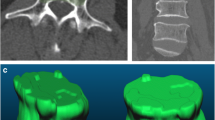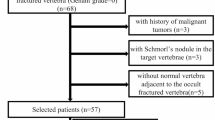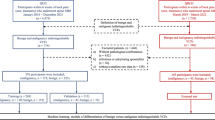Abstract
Purpose
The purpose of the study was to develop a predictive model for vertebral compression fracture (VCF) prior to spinal stereotactic body radiation therapy (SBRT) using radiomics features extracted from pre-treatment planning CT images.
Methods
A retrospective analysis was conducted on 85 patients (114 spinal lesions) who underwent spinal SBRT. Radiomics features were extracted from pre-treatment planning CT images and used to develop a predictive model using a classification algorithm selected from nine different machine learning algorithms. Four different models were trained, including clinical features only, clinical and radiomics features, radiomics and dosimetric features, and all features. Model performance was evaluated using accuracy, precision, recall, F1-score, and area under the curve (AUC).
Results
The model that used all features (radiomics, clinical, and dosimetric) showed the highest performance with an AUC of 0.871. The radiomics and dosimetric features model had the superior performance in terms of accuracy, precision, recall, and F1-score.
Conclusion
The developed predictive model based on radiomics features extracted from pre-treatment planning CT images can accurately predict the likelihood of VCF prior to spinal SBRT. This model has significant implications for treatment planning and preventive measures for patients undergoing spinal SBRT. Future research can focus on improving model performance by incorporating new data and external validation using independent data sets.




Similar content being viewed by others
References
Harel R, Angelov L (2010) Spine metastases: current treatments and future directions. Eur J Cancer 46:2696–2707
Bilsky MH, Lis E, Raizer J, Lee H, Boland P (1999) The diagnosis and treatment of metastatic spinal tumor. Oncologist 4:459–469
Ryu S, Fang Yin F, Rock J, Zhu J, Chu A, Kagan E, Rogers L, Ajlouni M, Rosenblum M, Kim JH (2003) Image-guided and intensity-modulated radiosurgery for patients with spinal metastasis. Cancer 97:2013–2018. https://doi.org/10.1002/cncr.11296
Jawad MS, Fahim DK, Gerszten PC, Flickinger JC, Sahgal A, Grills IS, Sheehan J, Kersh R, Shin J, Oh K (2016) Vertebral compression fractures after stereotactic body radiation therapy: a large, multi-institutional, multinational evaluation. J Neurosurg Spine 24:928–936
Gui C, Chen X, Sheikh K, Mathews L, Lo S-FL, Lee J, Khan MA, Sciubba DM, Redmond KJ (2021) Radiomic modeling to predict risk of vertebral compression fracture after stereotactic body radiation therapy for spinal metastases. J Neurosurg Spine 36:294–302
Kowalchuk RO, Johnson-Tesch BA, Marion JT, Mullikin TC, Harmsen WS, Rose PS, Siontis BL, Kim DK, Costello BA, Morris JM (2022) Development and assessment of a predictive score for vertebral compression fracture after stereotactic body radiation therapy for spinal metastases. JAMA Oncol 8:412–419
Boehling NS, Grosshans DR, Allen PK, McAleer MF, Burton AW, Azeem S, Rhines LD, Chang EL (2012) Vertebral compression fracture risk after stereotactic body radiotherapy for spinal metastases. J Neurosurg Spine 16:379–386
Lambin P, Rios-Velazquez E, Leijenaar R, Carvalho S, Van Stiphout RG, Granton P, Zegers CM, Gillies R, Boellard R, Dekker A (2012) Radiomics: extracting more information from medical images using advanced feature analysis. Eur J Cancer 48:441–446
Alsoof D, McDonald CL, Durand WM, Diebo BG, Kuris EO, Daniels AH (2023) Radiomics in spine surgery. Int J Spine Surg. https://doi.org/10.14444/8501
Arimura H, Soufi M, Kamezawa H, Ninomiya K, Yamada M (2019) Radiomics with artificial intelligence for precision medicine in radiation therapy. J Radiat Res 60:150–157
Ding H, Wu C, Liao N, Zhan Q, Sun W, Huang Y, Jiang Z, Li Y (2021) Radiomics in oncology: a 10-year bibliometric analysis. Front Oncol 11:689802
Gardin I, Grégoire V, Gibon D, Kirisli H, Pasquier D, Thariat J, Vera P (2019) Radiomics: principles and radiotherapy applications. Crit Rev Oncol Hematol 138:44–50
Moran A, Daly ME, Yip SS, Yamamoto T (2017) Radiomics-based assessment of radiation-induced lung injury after stereotactic body radiotherapy. Clin Lung Cancer 18:e425–e431
Li Q, Kim J, Balagurunathan Y, Liu Y, Latifi K, Stringfield O, Garcia A, Moros EG, Dilling TJ, Schabath MB (2017) Imaging features from pretreatment CT scans are associated with clinical outcomes in nonsmall-cell lung cancer patients treated with stereotactic body radiotherapy. Med Phys 44:4341–4349
Rose PS, Buchowski JM (2011) Metastatic disease in the thoracic and lumbar spine: evaluation and management. JAAOS-J Am Acad Orthopaed Surg 19:37–48
Kim J, Jang HS, Kim YS, Choi BO, Kang Y-n (2017) Comparison of spinal Stereotactic Body Radiotherapy (SBRT) planning techniques: intensity-modulated radiation therapy, modulated arc therapy, and helical tomotherapy. Med Dosim 42:210–215
Bo L, Zhang Z, Jiang Z, Yang C, Huang P, Chen T, Wang Y, Yu G, Tan X, Cheng Q, Li D (2021) Differentiation of brain abscess from cystic glioma using conventional MRI based on deep transfer learning features and hand-crafted radiomics features. Front Med 8:748144
Lu J, Ji X, Wang L, Jiang Y, Liu X, Ma Z, Ning Y, Dong J, Peng H, Sun F (2022) Machine learning-based radiomics for prediction of epidermal growth factor receptor mutations in lung adenocarcinoma. Disease Markers 2022
Shaw E, Kline R, Gillin M, Souhami L, Hirschfeld A, Dinapoli R, Martin L (1993) Radiation Therapy Oncology Group: radiosurgery quality assurance guidelines. Int J Radiat Oncol Biol Phys 27:1231–1239. https://doi.org/10.1016/0360-3016(93)90548-a
Cao T, Dai Z, Ding Z, Li W, Quan H (2019) Analysis of different evaluation indexes for prostate stereotactic body radiation therapy plans: conformity index, homogeneity index and gradient index. Precis Radiat Oncol 3:72–79
Fox S, Spiess M, Hnenny L, Fourney DR (2017) Spinal Instability Neoplastic Score (SINS): reliability among spine fellows and resident physicians in orthopedic surgery and neurosurgery. Global Spine J 7:744–748
Sahgal A, Atenafu EG, Chao S, Al-Omair A, Boehling N, Balagamwala EH, Cunha M, Thibault I, Angelov L, Brown P (2013) Vertebral compression fracture after spine stereotactic body radiotherapy: a multi-institutional analysis with a focus on radiation dose and the spinal instability neoplastic score. J Clin Oncol 31:3426–3431
Faruqi S, Tseng C-L, Whyne C, Alghamdi M, Wilson J, Myrehaug S, Soliman H, Lee Y, Maralani P, Yang V (2018) Vertebral compression fracture after spine stereotactic body radiation therapy: a review of the pathophysiology and risk factors. Neurosurgery 83:314–322
Acknowledgements
The authors wish to acknowledge the financial support of the Catholic Medical Center Research Foundation made in the program year of 2019. This study was supported by Advanced Institute for Radiation Fusion Medical Technology (AIRFMT) at Catholic University of Korea.
Funding
This study was funded by the Catholic Medical Center Research Foundation in the program year of 2019.
Author information
Authors and Affiliations
Corresponding author
Ethics declarations
Conflict of interest
There are no conflicts of interest to declare.
Ethical approval
This retrospective study was conducted without obtaining separate informed consent from the patients, as the data analyzed were obtained from medical records that were anonymized and de-identified to protect patient privacy.
Additional information
Publisher's Note
Springer Nature remains neutral with regard to jurisdictional claims in published maps and institutional affiliations.
Rights and permissions
Springer Nature or its licensor (e.g. a society or other partner) holds exclusive rights to this article under a publishing agreement with the author(s) or other rightsholder(s); author self-archiving of the accepted manuscript version of this article is solely governed by the terms of such publishing agreement and applicable law.
About this article
Cite this article
Seol, Y., Song, J.H., Choi, K.H. et al. Predicting vertebral compression fracture prior to spinal SBRT using radiomics from planning CT. Eur Spine J (2023). https://doi.org/10.1007/s00586-023-07963-3
Received:
Revised:
Accepted:
Published:
DOI: https://doi.org/10.1007/s00586-023-07963-3




